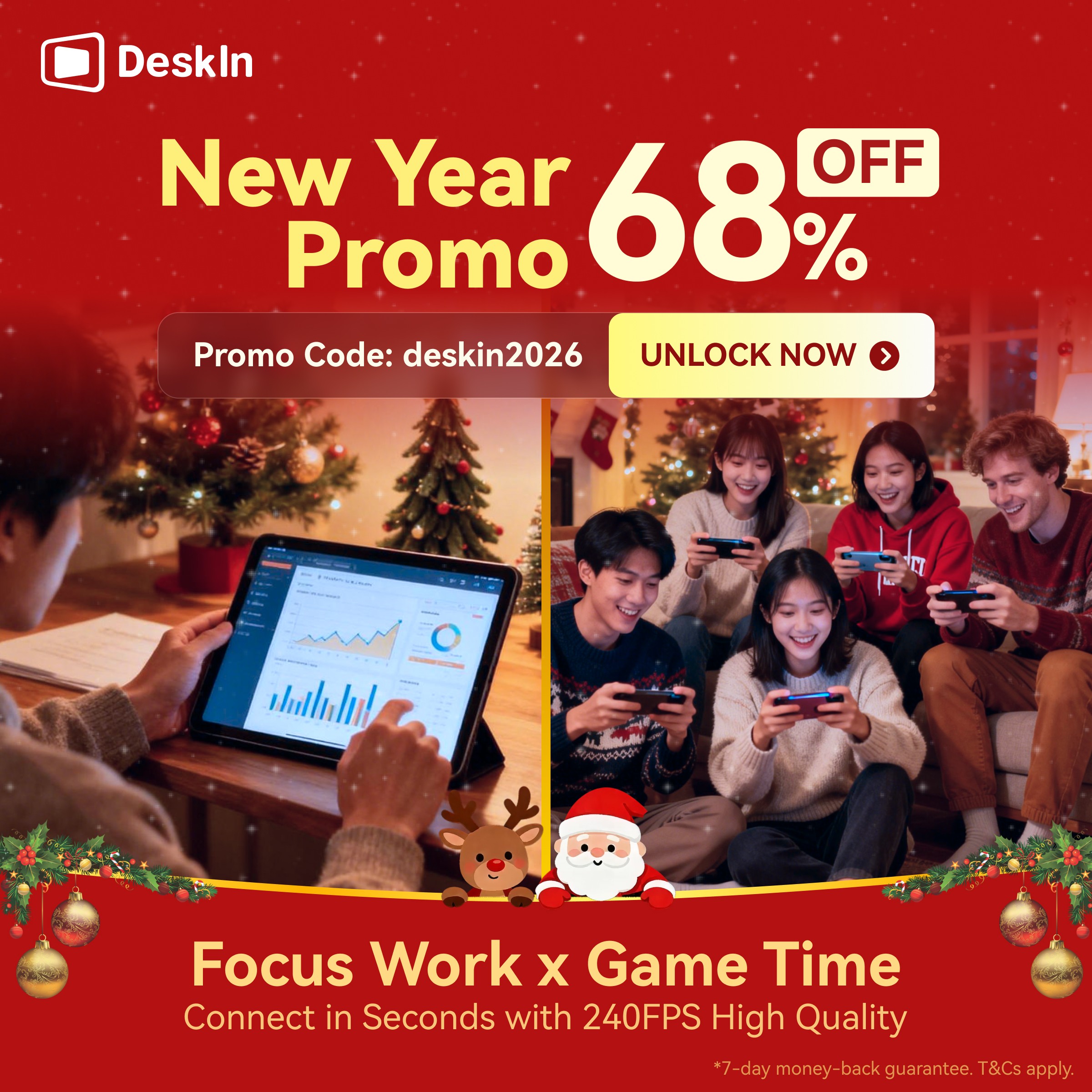Remote work and remote gaming are becoming more and more common and our requirements on remote desktop software are also getting higher and higher. In this article, we will analyze the main requirements for remote desktop software during remote work and remote gaming and compare the performance of two popular remote desktop software — DeskIn and AweSun. Let’s see which one is more suitable for you.
Needs in remote work scenarios
1. Remote work—smooth and stable connection
Using mobile devices or portable laptops to access remote high-performance PCs for design, editing work is the most common usage scenario for remote desktop. To make the work experience feel like it is being done locally, we require remote software to provide stable, smooth and low-latency remote connection.
2. Remote collaboration - file sharing, collaboration features
During remote teamwork, it’s often the case that we need to collaborate with our colleagues. For example, sharing files or screens in remote meetings for instant communication and feedback, and editing the files together during brainstorming. Therefore, we need remote desktop software that can provide rich collaboration features and screen management functions that allow us to conveniently collaborate with team members on the other side of the earth.
3. Cross-system compatibility - Perfect mapping and efficient device management
Working on devices with different operating systems and brands at the same time is not something uncommon. For example, having a MacBook at home and a Windows PC at the office. Remote desktop tools should support multiple operating systems, and can perfectly map the use of keyboard, mouse or other external devices between different systems to ensure smooth use.
4. Remote technical support - access multiple devices simultaneously
Remote technical support is also a most common usage scenario for remote desktop tools, especially for distributed offices. IT engineers need to respond quickly and provide immediate assistance for trouble shooting, software installation, or system updates. Sometimes, they even need to support multiple people at the same time. It would be great if the remote desktop software allows real-time communication between the 2 parties, so that the engineer can quickly understand the problem and solve it.
Comparison of DeskIn and Awesun’s performance for remote work.
Based on user needs in remote work scenarios: Stable and smooth connection, remote collaboration functions such as file transfer, multi-platform support and fast communication, etc. We analyzed the related functions and performance of DeskIn and AweSun for remote work:

DeskIn excels in stability, file transfer speed, and multi-person collaboration, making it especially suitable for remote work and teamworks that require efficient collaboration, while AweSun is more suitable only for daily light work
Needs in remote game scenarios
1. Remote demanding games - stable and smooth without lags
For FPS games that require precise operation and quick response, a slight delay can mean the difference between winning and losing. Therefore, remote players expect remote desktop tools to provide stable, high frame rate, low latency remote connection and therefore, smooth remote gaming experience.
2. Cross systems remote gaming —perfect mapping of keyboard, mouse, and gamepad
When connecting between different systems, the remote desktop software must ensure perfect mapping of the local and remote keyboard and mouse to ensure accurate control of remote games. If it allows using the local controllers to control remote games, it can improve the remote game experience to the next level.
3. Immersive gaming experience---big screen/dual screen gaming
Gamers may want to project the game to a larger screen to play or have a dual screen that can zoom in the corner map details or open the group chat. That requires the remote desktop software to provide corresponding screen management functions, which can help players obtain a more immersive gaming experience.
4. Unblock keyboard and mouse
Some games—mostly Korean games—restrict the use of third-party mouse and keyboard, such as Blade & Soul, Summoners War, MU Online, etc., leading to a situation where you can't control the remote PC with the virtual mouse. To solve this problem, remote tools need to provide virtual keyboard and mouse, bypassing these restrictions to ensure that players can operate the game remotely.
Comparison of DeskIn and Awesun’s performance for remote gaming.
Game performance has an increasing influence affecting people’s choice of remote desktop software. High image quality, low-latency and stable connections are crucial to the gaming experience. Here's a comparison of DeskIn and Awesun’s performance for remote gaming:

DeskIn and AweSun both have good performance and feature support for remote gaming, but they have quite different charging models. If you have 4 or more devices, DeskIn may be a more cost-effective choice for you.
Why choose DeskIn?
DeskIn combines stability, efficiency and versatility to provide an excellent remote control experience for both remote work and remote gaming needs. Here are the main benefits of DeskIn:
Stable and smooth: Provides stable and smooth connection, no connection time limit and won't drop.
Low latency and high image quality: <40ms low latency, up to 4K image quality, suitable for immersive gaming and design work.
Fast file transfer: Supports up to 12MB/S high-speed transfer of large files between PCs and mobile devices, no size and format limit.
Powerful collaboration features: Supports multi-session connection extend screen, mirror screen and audio call, improving team collaboration efficiency.
Cross-platform capabilities: Compatible with Windows, macOS, iOS and Android, easily manage all your smart devices.
Conclusion
DeskIn and AweSun are both excellent remote desktop software, if you are gamers, both DeskIn and Awesome can provide a very good remote gaming experience. If you mainly use it for remote working and collaboration, there is no doubt that DeskIn can provide richer functions and more stable connections, giving you a more efficient remote working experience. Download it now and give it a try!
Remote work and remote gaming are becoming more and more common and our requirements on remote desktop software are also getting higher and higher. In this article, we will analyze the main requirements for remote desktop software during remote work and remote gaming and compare the performance of two popular remote desktop software — DeskIn and AweSun. Let’s see which one is more suitable for you.
Needs in remote work scenarios
1. Remote work—smooth and stable connection
Using mobile devices or portable laptops to access remote high-performance PCs for design, editing work is the most common usage scenario for remote desktop. To make the work experience feel like it is being done locally, we require remote software to provide stable, smooth and low-latency remote connection.
2. Remote collaboration - file sharing, collaboration features
During remote teamwork, it’s often the case that we need to collaborate with our colleagues. For example, sharing files or screens in remote meetings for instant communication and feedback, and editing the files together during brainstorming. Therefore, we need remote desktop software that can provide rich collaboration features and screen management functions that allow us to conveniently collaborate with team members on the other side of the earth.
3. Cross-system compatibility - Perfect mapping and efficient device management
Working on devices with different operating systems and brands at the same time is not something uncommon. For example, having a MacBook at home and a Windows PC at the office. Remote desktop tools should support multiple operating systems, and can perfectly map the use of keyboard, mouse or other external devices between different systems to ensure smooth use.
4. Remote technical support - access multiple devices simultaneously
Remote technical support is also a most common usage scenario for remote desktop tools, especially for distributed offices. IT engineers need to respond quickly and provide immediate assistance for trouble shooting, software installation, or system updates. Sometimes, they even need to support multiple people at the same time. It would be great if the remote desktop software allows real-time communication between the 2 parties, so that the engineer can quickly understand the problem and solve it.
Comparison of DeskIn and Awesun’s performance for remote work.
Based on user needs in remote work scenarios: Stable and smooth connection, remote collaboration functions such as file transfer, multi-platform support and fast communication, etc. We analyzed the related functions and performance of DeskIn and AweSun for remote work:

DeskIn excels in stability, file transfer speed, and multi-person collaboration, making it especially suitable for remote work and teamworks that require efficient collaboration, while AweSun is more suitable only for daily light work
Needs in remote game scenarios
1. Remote demanding games - stable and smooth without lags
For FPS games that require precise operation and quick response, a slight delay can mean the difference between winning and losing. Therefore, remote players expect remote desktop tools to provide stable, high frame rate, low latency remote connection and therefore, smooth remote gaming experience.
2. Cross systems remote gaming —perfect mapping of keyboard, mouse, and gamepad
When connecting between different systems, the remote desktop software must ensure perfect mapping of the local and remote keyboard and mouse to ensure accurate control of remote games. If it allows using the local controllers to control remote games, it can improve the remote game experience to the next level.
3. Immersive gaming experience---big screen/dual screen gaming
Gamers may want to project the game to a larger screen to play or have a dual screen that can zoom in the corner map details or open the group chat. That requires the remote desktop software to provide corresponding screen management functions, which can help players obtain a more immersive gaming experience.
4. Unblock keyboard and mouse
Some games—mostly Korean games—restrict the use of third-party mouse and keyboard, such as Blade & Soul, Summoners War, MU Online, etc., leading to a situation where you can't control the remote PC with the virtual mouse. To solve this problem, remote tools need to provide virtual keyboard and mouse, bypassing these restrictions to ensure that players can operate the game remotely.
Comparison of DeskIn and Awesun’s performance for remote gaming.
Game performance has an increasing influence affecting people’s choice of remote desktop software. High image quality, low-latency and stable connections are crucial to the gaming experience. Here's a comparison of DeskIn and Awesun’s performance for remote gaming:

DeskIn and AweSun both have good performance and feature support for remote gaming, but they have quite different charging models. If you have 4 or more devices, DeskIn may be a more cost-effective choice for you.
Why choose DeskIn?
DeskIn combines stability, efficiency and versatility to provide an excellent remote control experience for both remote work and remote gaming needs. Here are the main benefits of DeskIn:
Stable and smooth: Provides stable and smooth connection, no connection time limit and won't drop.
Low latency and high image quality: <40ms low latency, up to 4K image quality, suitable for immersive gaming and design work.
Fast file transfer: Supports up to 12MB/S high-speed transfer of large files between PCs and mobile devices, no size and format limit.
Powerful collaboration features: Supports multi-session connection extend screen, mirror screen and audio call, improving team collaboration efficiency.
Cross-platform capabilities: Compatible with Windows, macOS, iOS and Android, easily manage all your smart devices.
Conclusion
DeskIn and AweSun are both excellent remote desktop software, if you are gamers, both DeskIn and Awesome can provide a very good remote gaming experience. If you mainly use it for remote working and collaboration, there is no doubt that DeskIn can provide richer functions and more stable connections, giving you a more efficient remote working experience. Download it now and give it a try!


















